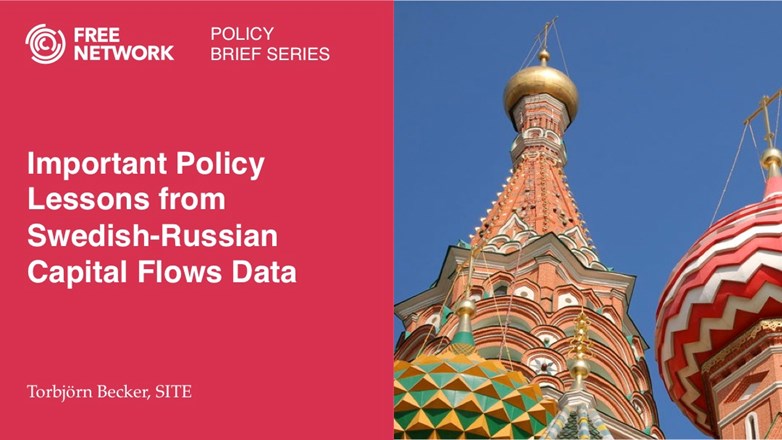What policy lessons can be learned from Swedish-Russian capital flows?
A recent study of capital flows between Sweden and Russia provides many policy lessons that are highly relevant for the current economic situation in Russia. In line with studies on other countries, bilateral FDI flows were more stable than portfolio flows, which is important for a country looking for predictable external sources of funding. However, much of the FDI flows came with trade and growth of the Russian market. The sharp decline in imports and fall in GDP is therefore bad news also when it comes to attracting FDI. The conclusion is (again) that institutional reforms and reengaging with the West are crucial policies to stimulate both the domestic economy and encourage much-needed FDI.
In a recent paper (Becker 2016), I take a detailed look at the trends and nature of bilateral capital flows between Sweden and Russia over that last 15 years. Although the paper focuses on the capital flows of a relatively small country like Sweden with Russia, it sheds some light on more general theoretical and empirical issues associated with FDI and portfolio flows that are highly relevant for Russia today.
Measuring Bilateral FDI
One general qualifier for studies of bilateral capital flows is however the reliability of data; Not only is a significant share of international capital flows routed through offshore tax havens which makes identifying the true country of origin and investment difficult, but also many investing companies are multinationals (MNEs) with operations and shareholders in many countries so it is hard to have a clear definition of what is a “Swedish” or a “Russian” company. In addition, when different official data providers, in this case Statistics Sweden (SCB) and the Central Bank of Russia (CBR), report capital flows on the macro level, there are large discrepancies.
Private companies also gather company level data on FDI that can be aggregated and compared with the macro level FDI data. This data is on gross FDI flows and should not be expected to be the same as the net macro level FDI flows data but is a bit of a “reality check” of the macro data.
Figure 1. Average annual FDI flows
 Sources: SCB, CBR, fDi Market, MergerMarkets
Sources: SCB, CBR, fDi Market, MergerMarkets
The reported annual average flow of FDI from Sweden to Russia varies from around USD500 million to USD1.2 billion depending on the data source. Russian flows to Sweden are rather insignificant regardless of the source but the different sources do not agree on the sign of the net flows (Figure 1).
The differences between data sources suggest that some caution is warranted when analyzing bilateral FDI flows. With this caveat in mind, there are still some clear patterns in the capital flows data from Sweden to Russia that emerge and carries important policy lessons in the current Russian economic environment.
FDI vs. Portfolio Investments
There is a large literature discussing the distinguishing features of FDI and portfolio flows (see Becker 2016 for a summary). Some of the key macro economic questions include which type of flows provides most international risk sharing; are most stable over time; or most likely to contribute to balance of payments crises when the flows go in reverse. In addition, there are potential differences in terms of the amount of international knowledge transfers and how different types of capital flows respond to institutional factors.
Figure 2. FDI and portfolio investments
 Source: SCB
Source: SCB
Figure 2 shows that FDI has been much more stable than portfolio flows in the years prior to and after the global financial crisis as well as in more recent years. Although all types of capital flows respond negatively to poor macroeconomic performance, and the stock of portfolio investments swing around much faster than FDI investments, i.e., portfolio flows go in reverse more easily and can contribute to external crises. This makes FDI a more preferable type of capital flow for Russia.
FDI and Trade Go Together
Since FDI is a desired type of capital flow, it is important to understand its driving forces. The first question to address is whether FDI and trade are substitutes or complements. Since the bulk of FDI comes from MNEs that operate in many countries, we can imagine cases both when FDI supports existing trade and cases when it is aimed at replacing trade by moving production to the country where the demand for the goods is high.
In the case of Sweden and Russia, the macro picture is clear; FDI has increased very much in line with Swedish exports to Russia (Figure 3). Both of these variables are of course closely correlated with the general economic development in Russia, but even so, the very close correlation between FDI and trade over the last 15 years suggests that they are compliments rather than substitutes.
Figure 3. Swedish Exports and FDI to Russia
 Source: SCB
Source: SCB
Most FDI is Horizontal
FDI flows are often categorized in terms of the main motivating force for MNEs to engage in cross-border investment: vertical (basically looking for cheaper inputs), horizontal (expanding the customer base), export-platform (producing abroad for export to third countries) or complex (a mix of the other reasons) FDI.
Looking at the sectoral composition of FDI from Sweden to Russia (Figure 4), most investments have come in sectors where it is clear that MNEs are looking to expand their customer base. Even in the case of real estate investments, a large share is IKEA developing new shopping centers that host their own outlets together with other shops. Communication and financial services are also mostly related to service providers looking for new customer. Only a small share is in natural resource sectors that would be more in line with vertical FDI, while there are very few (if any) examples of MNEs moving production to Russia to export to third countries.
Figure 4. Sectors of Swedish FDI to Russia
 Source: SCB
Source: SCB
Policy conclusions
The above figures on bilateral capital flows from Sweden to Russia carry three important policy messages: 1) FDI is more stable than portfolio flows; 2) Trade goes hand in hand with FDI; and 3) FDI to Russia has mostly been horizontal and driven by an expanding customer base.
In the current situation where Russia should focus on policies to attract private capital inflows, the goal should be to attract FDI. Instead, the government is now looking for portfolio inflows in the form of a USD3 billion bond issue. But FDI is a more stable type of international capital than portfolio flows and also come with the potential of important knowledge transfers both in terms of new technologies and management practices.
However, as we have seen above, FDI inflows have in the past been correlated with increased trade and an expanding Russian market. In the current environment, where imports with the West declined by 30-40 percent in the last year, GDP fell by around 4 percent, and the drop in consumers’ real incomes have reached double digits in recent months, it is hard to see any macro factors that will drive FDI inflows.
Instead, attracting FDI in this macro environment requires policy changes that remove political and institutional barriers to investments. The first step is to fulfill the Minsk agreement and contribute to a peaceful solution in Ukraine that is consistent with international laws. This would not only remove official sanctions but also provide a very serious signal to foreign investors that Russia plays by the international rulebook and is a safe place for investments from any country.
The second part of an FDI-friendly reform package should address the institutional weaknesses that in the past have reduced both foreign and domestic investments. It is telling that many papers that look at the determinants of FDI flows to transition countries include a ‘Russia dummy’ that is estimated to be negative and both statistically and economically significant (see e.g. Bevan, Estrin and Meyer, 2004 and Frenkel, Funke, and Stadtmann, 2004). One factor that reduces the significance of the ‘Russia dummy’ is related to how laws are implemented. Other studies point to the negative effect corruption has on FDI.
Reducing corruption and improving the rule of law are some of the key reforms that would have benefits far beyond attracting FDI and has been part of the Russian reform discussion for a very long time. It was also part of the reform program that then-President Medvedev presented to deal with the situation in 2009 together with a long list of other structural reforms that would help modernize the Russian economy and society more generally.
As the saying goes, don’t waste a good crisis! It is time that Russia implements these long-overdue reforms and creates the prospering economy that the people of Russia would benefit from for many generations.
References
- Becker, T, 2016, “The Nature of Swedish-Russian Capital Flows”, SITE Working paper 35, March.
- Bevan, A, Estrin, S & Meyer, K 2004, “Foreign investment location and institutional development in transition economies”, International Business Review, vol. 13, no. 1, pp.43-64.
- Frenkel, M, Funke, K & Stadtmann, G 2004, “A panel analysis of bilateral FDI flows to emerging economies”, Economic Systems, vol. 28, no. 3, pp. 281-300.
This policy brief is published on Forum for Research on Eastern Europe and Emerging Economies (FREE Network) Policy brief series. FREE Network is a joint initiative by seven think tanks - SITE (Stockholm), BEROC (Minsk), BICEPS (Riga), CEFIR (Moscow), CenEA (Szczecin), ISET (Tbilisi) and KSE (Kiev). Together, these research institutes form an extensive network of leading academic experts on economic issues in Central and Eastern Europe and the former Soviet Union. For more information please visit the website of FREE Network here.
Download the Working paper "The Nature of Swedish-Russian Capital Flows" here or read it on SITE's Slideshare channel.




